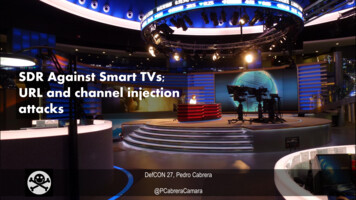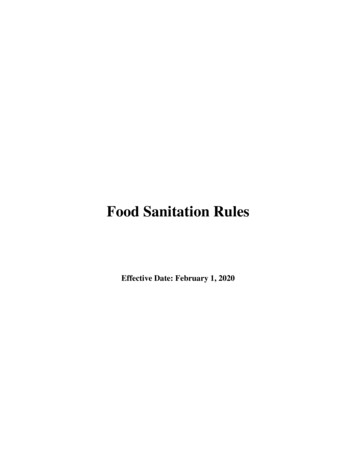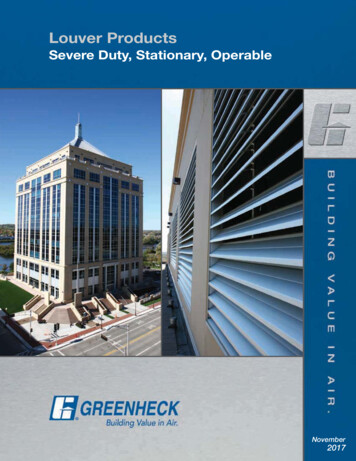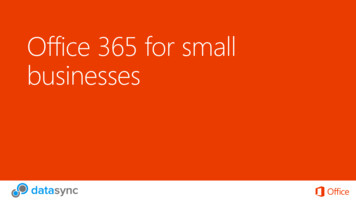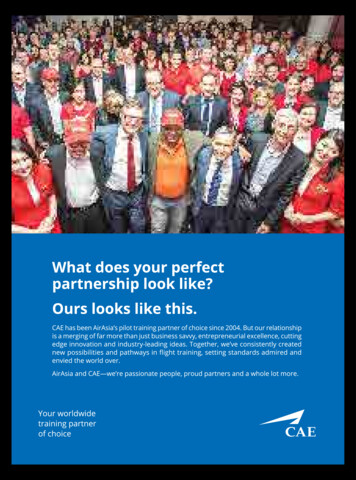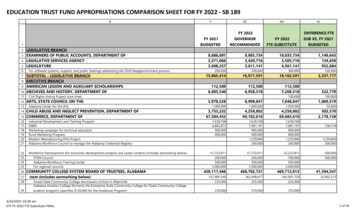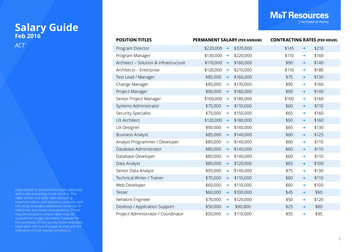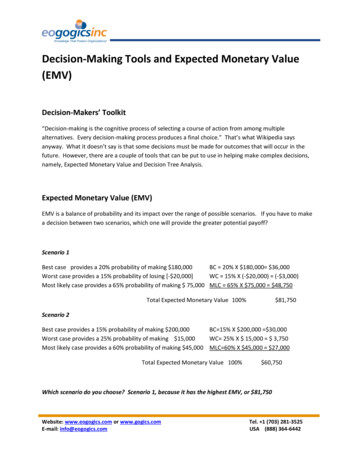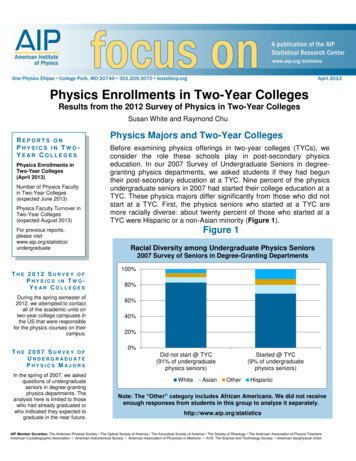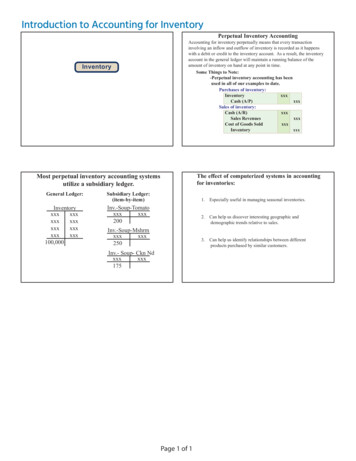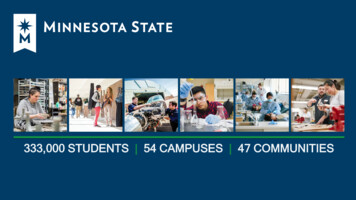
Transcription
333,000 STUDENTS 54 CAMPUSES 47 COMMUNITIES
Overview of today’s discussionJay Cowles, ChairBoard of TrusteesMinnesota State GovernanceDevinder MalhotraChancellorSystem Overview and Strategic DirectionBill MakiVice Chancellor of FinanceBiennial Budget Request2
Minnesota State VisionIt is the core value of Minnesota State to provide an opportunity forall Minnesotans to create a better future for themselves, for theirfamilies, and for their communities.3
Governance 15 memberBoard of Trustees Appointed byGovernor andconfirmed bySenate 8 Trustees fromCongressionaldistricts: 4 at-large(6-year terms) 3 studentTrustees(2-year terms)Minnesota State Trustees:First Row: Board Chair Jay Cowles, Board Vice Chair Roger Moe, AhmitaraAlwal, Asani Ajogun, Alex CirilloSecond Row: Dawn Erlandson, Jerry Janezich, Javier Morillo, AprilNishimura, Oballa OballaThird Row: Rudy Rodriguez, Kathy Sheran, George Soule, Cheryl Tefer,Michael Vekich4
We are Minnesota State333,000 Students annually 233,000 in credit classes 100,000 in non-credit programs 65% in greater Minnesota 113,000 from underrepresented groups 42,200 first generation students 8,800 veterans37 Colleges and Universities with54 Campuses 7 universities 30 colleges47 Communities across the State From International Falls to Worthington Enrollment ranges from 302to 17,3705
In FY2017, the colleges and universities ofMinnesota State generated an economicimpact of 8 billion in the state: 4.1 billiondirect and 3.9 billion indirect and induced.This impact is the result of:» operational spending» capital spending (10-year average)» payroll and benefits paid toemployees» student spending» visitor spendingBased upon this impact, 1 out of every 42in the Minnesota economy is supported byMinnesota State.6
Our core commitmentsMinnesota State plays an essential role in growing Minnesota’seconomy and opening the doors of educational opportunity to allMinnesotans. Our colleges and universities:» Ensure access to an extraordinary education for all Minnesotans.» Are the partner of choice to meet Minnesota’s workforce andcommunity needs.» Deliver to students, employers, communities, and taxpayers thehighest value/most affordable higher education option.7
State University PresidentsPresident Faith HensrudBemidji State UniversityNorthwest Technical CollegePresident Robbyn WackerSt. Cloud State UniversityPresident Ginny ArthurMetropolitan State UniversityPresident Richard DavenportPresident Anne BlackhurstMinnesota State University, Mankato Minnesota State University MoorheadPresident Kumara JayasuriyaSouthwest Minnesota State UniversityPresident Scott OlsonWinona State University8
College PresidentsMichael SeymourKent HansonAlexandria Technical &Anoka-Ramsey CCCommunity College Anoka Technical CollegeHara CharlierCentral Lakes CollegePatricia RogersMerrill Irving, Jr.Michael RaichHennepin Technical College Northeast Higher Ed Dist. Lake Superior CollegeAngelia MillenderCentury CollegeMichael BerndtStephanie HammittDakota County TCFond du Lac Tribal & CCInver Hills Community CollegeSharon PierceLarry LundbladMinneapolis College MN State College SoutheastCarrie BrimhallM State9
College PresidentsTerry GaalswykMinnesota West C&TCJoyce EsterNormandale CCRolando GarcíaNorth Hennepin CCAdenuga AtewologunRiverland Community CollegeJeffery BoydRochester C&TCAnnesa CheekSt. Cloud T&CCShannon JesmeNorthland C&TCDeidra PeasleeSt. Paul CollegeJoe MulfordPine Technical & CCAnnette ParkerSouth Central CollegeCraig JohnsonRidgewater College10
We educate the entire talent pipeline 39,000 awards conferred annually 4,000 academic programs, from certificate to applieddoctorate 5,800 students transfer from a system college to a systemuniversity 13,500 customized/specialty/occupational andprofessional classes11
We educate 9 out of 10 mechanics9 out of 10 in manufacturing8 out of 10 in law enforcement2 out of 3 nurses7 out of 10 in trades6 out of 10 in agriculture4 out of 10 in business1/2 of all teachers1/2 of IT professionals12
Minnesota State partners with employers toeducate and train their workforce» Across Minnesota State, there are examples of partnerships with local andstatewide employers to address workforce shortages.» On many campuses, this work is done with a local Advisory Council, whichseeks input from employers, alumni, and economic developmentprofessionals to ensure programming is tied to exactly what local employersneed.» The consistent focus among campus leaders is to ensure graduates have jobsthat encourage them to stay in the region.» More than 36,500 students graduate from our colleges and universities eachyear and use their know-how to help businesses, industries, public-sectororganizations, nonprofits, and communities across the state to grow andthrive.13
Minnesota State is addressing racial andeconomic disparities»»The most effective strategy Minnesota has for narrowing itsprosperity gap is to ensure all Minnesotans get the education theyneed to secure a better future for themselves, their families, andtheir communities.The diversity of our students is one of our greatest strengths.Minnesota State is proud to serve more students of color andAmerican Indian students and more low-income students than allother higher education providers in Minnesota combined.14
FY2022-FY2023 Budget Request 120 million in new funding over the biennium 75 million for campus responsiveness and stabilization to supportincreases in campus expenses resulting from the pandemic andinflationary costs over the biennium 45 million for equity and affordability to directly support our students’critical needs:ooooooStudent Basic NeedsMental Health NeedsAdditional Campus Support ServicesCareer and Technical EducationOpen Educational ResourcesNew Scholarship programs15
FY2022-FY2023 Budget RequestCampus Responsiveness and Stabilization 75 million Supporting Minnesota State is critical for the state of Minnesota’seconomic recovery Campuses require on‐going revenue in order to maintain a core levelof programs and services Funding of inflationary costs and increased campus expenses due tothe pandemic16
FY2022-FY2023 Budget RequestEquity and Affordability 45 million Scholarship programs to support economically vulnerable students 23M of the 45M Expansion of support for basic student needs including mental health needs andcampus student support services 15M of the 45M Career and Technical Education support 6M of the 45M Open educational resources 1M of the 45M17
FY2022-FY2023 Budget RequestMinnesota State AccessScholarship Programs 23 millionSupporting students with greatest financial need Pell‐eligible Minnesota residents New or transfer students at any Minnesota State college or university Returning students enrolled at any Minnesota State college or university prior to the start ofthe Access and Momentum program Students pursuing an undergraduate diploma, certificate, associate degree, or bachelor degree Enrollment of at least 3 credits per term, up to 60 credits at two-year colleges and 30 credits atuniversities Students with remaining need after federal and state grants are applied to tuition and fees18
FY2022-FY2023 Budget RequestEquity and AffordabilityBasic Needs and Support Services 15 million Emergency grants Stigma‐free and online mental health assessment tools and mental health firstaid type resources Easily accessible information hub to connect students to local, county, and stateresources that address basic needs Training and support for faculty, staff, and administrators to ensure thatprograms are designed to be easily accessible to all students, specificallyfocusing on students from racial, ethnic, and indigenous populations, lowincome and first generational19
FY2022-FY2023 Budget RequestEquity and AffordabilityCareer and Technical Education 6 million Short‐term education programs and industry‐specific training certificatespartnering with organizations serving communities of color and indigenouscommunities Local partnership efforts with local businesses to help connect high schoolstudents with college programs that will get them into in‐demand skilled andtechnical careers Career and Technical Teaching program support to address shortages in highschool and college teachers in career and technical areas20
FY2022-FY2023 Budget RequestEquity and AffordabilityOpen Educational Resources 1 millionDirectly reducing students out of pocket costs by removingtextbook costs; this effort would include Searching out new free resources Expanding current offerings Implementing new offerings21
Thank You22
Minnesota State Access. Scholarship Programs 23 million Supporting students with greatest financial need Pell-eligible Minnesota residents New or transfer students at any Minnesota State college or university Returning students enrolled at any Minnesota State college or university prior to the start of the Access and Momentum program
